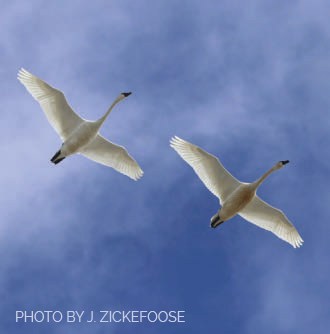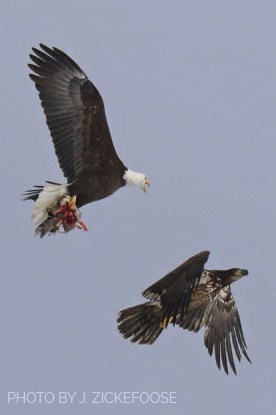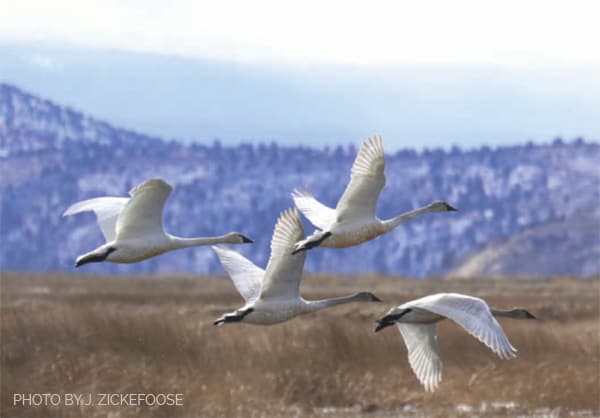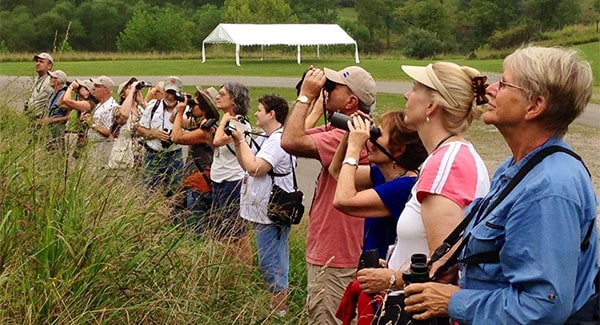This is one festival you have to do,” Bill said, and when Bill says that, I listen. “Beautiful place. Great people. Fabulous birds. Unbelievable photo ops. And it’s an adventure getting there. You’re in a valley in the mountains with lakes.” I felt my pulse quicken. I looked at my calendar, took a deep breath, and said yes to the invitation to speak at the 2019 Winter Wings Festival in Klamath Falls, Oregon, held yearly around Valentine’s Day weekend.
Accepting any speaking engagement is a leap of faith, but this was a giant one, all the way to the northwestern corner of the country. And it was an adventure getting there, as winter travel so often is. A huge winter storm was busy blanketing the West with snow all the way from Oregon to Arizona, and I was thankful the festival organizers had advised me to pad my travel time with a couple of days for the inevitable delays. I learned a lot. I didn’t know, for instance, that San Francisco’s airport shuts down and turns into a ghost town when strong winds blow from the southwest. Nor did I know that last night’s takeout hot and sour soup makes a fabulous breakfast. A night in San Francisco and I was on my way again to Medford, Oregon. From there, it would be a 90-minute drive to Klamath Falls, with the Cascade Range in between.
Once again, I bowed to the wisdom of festival organizer Anne Wenner, who dispatched local birder B.J. Matzen, Esquire, over the Cascades to pick me up. I’d have been willing to drive, but not having to was a great blessing, given the five-foot snowpack and ongoing snow in the pass. B.J. proved the most gracious and informed of guides, taking me for a quick tour of Medford, with a swing through 4 Daughters Irish Pub, and Harry and David’s flagship fruit store before we set out for Klamath Falls. I was settled in my room at the Running Y Ranch Resort by nightfall, looking forward to the festival.
B.J. and I started the next morning early, birding our way down to Lower Klamath Lake National Wildlife Refuge near the California line. If you have a yen for raptors and waterfowl, this is the place. I’m sure I saw more shovelers in 20 minutes than I’ve seen in my entire life, all busily straining the mud of Lower Klamath Lake. The farm fields all around were dotted with rough-legged hawks and northern harriers, and it was a treat to ogle the many color variants and plumages of red-tailed hawk. A single ferruginous hawk stood out like a stately gargoyle on the flat expanse. Occupying a starring role in our day were a nesting golden eagle and countless bald eagles. The latter were once so scarce here, thanks to DDT contamination, that every nest was intensively studied.
Winter Wings, in fact, was first conceived 40 years ago by the Klamath Basin Audubon Society as a symposium for bald eagle research. From scientific paper presentations before a small audience of eagle researchers and fans, the event slowly morphed into a birding festival still staffed entirely by volunteers, even as Haliaeetus leucocephalus has graduated from endangered species to common fixture in the area.

And what an area it is! The Klamath Basin is squarely on the Pacific Flyway and is host to great flocks of migrant and wintering waterfowl. Twenty-four species of geese, ducks, and swans were spotted at 2019’s festival. Typically, from 500 to 800 bald eagles winter in the basin—the largest concentration in the Lower 48. And what are those eagles eating? Waterfowl, supplemented with fish and the occasional cow carcass. Every large gathering of waterfowl seems to have its attendant eagles, standing around on the ice like hopeful undertakers, hoping someone will fall ill. Anywhere waterfowl concentrate, a few will die, and bald eagles are only too happy to take care of those. One dead tundra swan can attract as many as 50 bald eagles, which swiftly reduce it to a puff of feathers on the ice.
Speaking of swans, I was utterly unprepared for the tundra swans of Klamath Basin. I knew there would be swans, but their sheer numbers, their high, hollow voices, and the way their whites changed in every light regime held me in thrall. The swans settled out as my favorite birds on our Saturday morning field trip along Upper Klamath Lake, billed as a “Casual Morning with Julie Zickefoose.” Led by local experts Kevin Spencer and Dave Haupt, our group reveled in great looks at all manner of ducks and raptors, eagles, and even a northern shrike, all set to the merry tune of singing red-winged blackbirds.

It was one of the best birding mornings of my life, and I told Kevin so. He was a bit taken aback that the common wintering species they sorted through every day could bring me such enjoyment. He smiled and replied, “Well, if it was that good a day for you, it was a good day for us, too.” But the quality of a birding day is all in your perspective. I come from a landlocked corner of southern Ohio, where waterfowl and swans are in very short supply. No Pacific flyway for me. I felt I could watch those swans dropping into the lake for the rest of my life and never tire of it. As the light rose and died, the swans changed color, sometimes ivory; sometimes shadow blue or sunset pink, depending on the backdrop and the light. The blank slate of their white plumage took on color as if they’d been dyed. How could one tire of watching that?
After the field trip, I surrendered to my swan fixation, bundled myself up in layers, boots and lined pants, and set out on a solo quest. There was a pebbled white line of them on what open water there was, and I set out to get close enough for some photos. It was a long walk, and it was very cold, albeit sunny. I amused myself by tracking ravens and redtails, admiring the writing of their feet and wings on the snow. I walked alongside a flooded barley field. The farmer had taken compensation for a ruined crop, which, despite the flooding, produced a bumper load of grain. Because it was never harvested, the field was a banquet for granivores. Swans, geese, and ducks were happy to clean it up, and an explosion of voles did their part, too. Four northern harriers quartered along the snowy field beside me as I walked. Each time one would pinwheel onto its side and drop to grab a vole, a raven or a redtail would swoop in to try to cadge the prize. I took to photographing the interactions and was lucky enough to have my lens on a harrier when an arrow-swift, tapered missile came in low. Black wingpits betrayed a prairie falcon, a rare gift for an Ohio bird watcher. Again and again, the falcon shot past, turned, and harassed the harrier, but the hawk managed to choke the vole down and resume her hunt.
Meanwhile, bald eagles were scrapping overhead. I swung my lens on a pair—an enormous immature female, chasing an adult male. From his talons hung the attenuated scraps of a drake mallard, its green head and orange feet flopping as the birds fought. It was a stunning sight, and I was surprised to see the young female succeed in robbing her elder of his prey. She had a bright future as a pirate ahead of her.
Finally, I was close enough to the swans to begin to shoot photos. Just a bit closer, and three swan heads came up. Another step or two, and five more heads shot up, until the entire flock was on alert. It made a striking image, but I knew what would come next—the whole flock would take wing. As exciting as that might have been, disturbing the swans was the last thing I wanted to do. Slowly, I turned around and retraced my steps, and was relieved to see their heads lower as they gradually relaxed and went back to dozing, preening and feeding. High, happy, mellow hoots replaced their low murmurs of alarm. Walking gently on the earth includes keeping the peace with wild things.

What a delight it was exploring the Klamath Basin and its marvelous birds. Not to be outdone was the glorious diversity of evergreen trees. The bark of very old ponderosa pines turns pumpkin-orange, glowing warm against the snow and their dark needles. Junipers of several species lend feathery textures, and firs tower, frosted with snow like a living Christmas card. Sifting through these forests on Running Y Ranch property were oak/juniper titmice (you can’t tell them apart), California scrub-jays, Steller’s jays, mountain chickadees, and pygmy, red-breasted, and white-breasted nuthatches. I took a careful look and listened to the latter, because there’s some talk of splitting Pacific white-breasted nuthatches from interior birds. Their voices were certainly different. The clown-painted faces of a little troop of acorn woodpeckers were a delightful surprise, as were the deer slipping through the trees, said to be a cross between black-tailed and mule. Despite two fervent searches, I missed seeing a white-headed woodpecker—all the more reason to return!
If you have an itch like mine, for the open spaces and shimmering colors of the Pacific Northwest, put Klamath Falls’ Winter Wings Festival on your list. A banquet of field trips will be your intro to landscapes and birds that will leave you breathless. Give yourself a little extra time to get there and some time afterward to wander, to see eagles spar and tumble overhead, to watch ivory-white swans turn from peach to cobalt in the last light of day.




